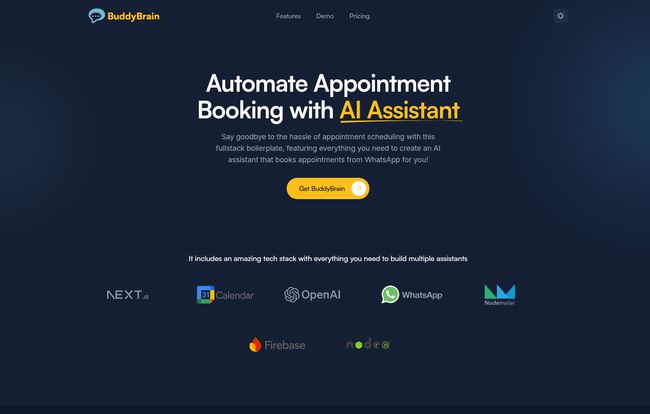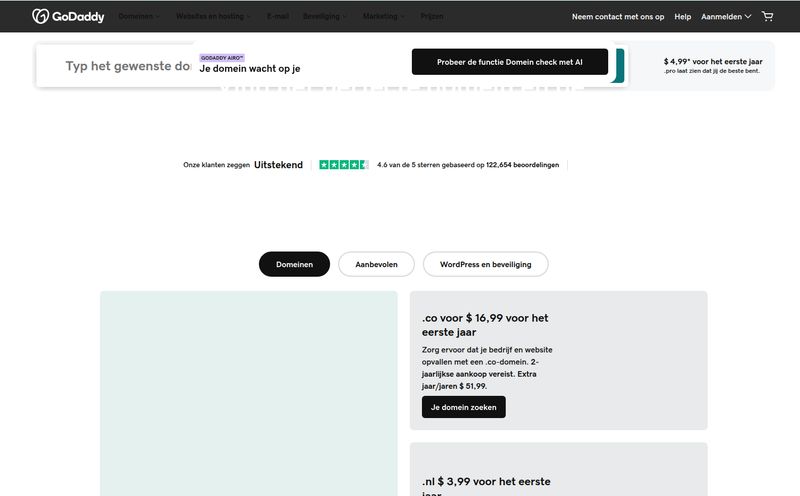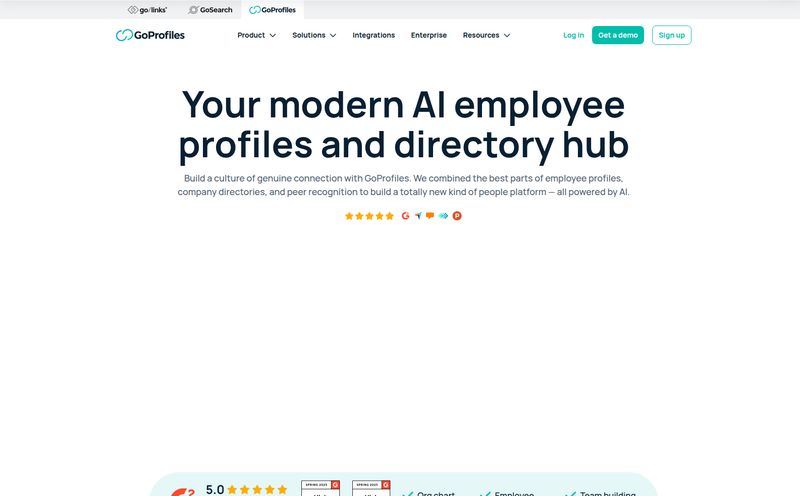We've all been there. You're scrolling through Twitter, see another slick demo of an AI assistant effortlessly booking appointments, and you think, "I could build that." It's the classic developer's itch. The siren song of a new side project.
Then reality hits you like a ton of bricks. Or, more accurately, like a mountain of API documentation. You start mapping it out: you'll need a backend, probably NodeJS. A frontend, maybe Next.js to keep it modern. Then you've got to wrestle with the Google Calendar API and its OAuth 2.0 shenanigans. Don't even get me started on integrating WhatsApp. And after all that, you still need to figure out how to make an AI actually understand and respond intelligently. Suddenly, your weekend project has turned into a six-month sentence.
I’ve seen dozens of tools promise to simplify this process, but they're often closed-box, expensive SaaS platforms. So when I stumbled upon BuddyBrain, which offers a full-stack boilerplate for a one-time fee, my curiosity was piqued. A boilerplate? As in, you get the actual source code? For the price of lunch? Okay, you have my attention.
So What in the World is BuddyBrain Anyway?
Think of BuddyBrain not as a finished car, but as a high-performance rolling chassis. It’s a full-stack SaaS boilerplate—a pre-built code foundation—that gives you everything you need to launch your own AI-powered virtual scheduling assistant. You get the engine (NodeJS express), the body (NextJS), the navigation system (Google Calendar API), the communication device (WhatsApp integration), and the brain (OpenAI's ChatGPT). All you have to do is put on the custom paint job and turn the key.
The core idea is simple and, frankly, brilliant: an assistant that converses with your customers over WhatsApp to book, reschedule, and even cancel appointments directly in your Google Calendar. No more back-and-forth emails. No more phone tag. Just a simple, automated conversation.
The Big Question: Why Not Just Build It Yourself?
I can hear the code-purists typing already. "Why would I pay for code I could write myself?" And that's a fair question. The answer, as anyone who values their sanity will tell you, is time. And money, because time is money.
BuddyBrain's landing page makes a bold claim: it saves you weeks of work. I was skeptical, but after looking at the stack, I believe it. I once tried to build a simple Google Calendar integration for a personal project, and the authentication alone was a character-building experience I wouldn't wish on my worst enemy. BuddyBrain has already done that grunt work.
They’ve already connected the dots between all these different services. More importantly, they claim their "algorithm intearacts with ChatGPT responses to perform actions." That's the secret sauce right there. It’s not just about sending a prompt to OpenAI; it’s about interpreting the response and turning it into a concrete action, like creating a calendar event with the right date, time, and details. That's where the real development headache lives, and they've seemingly solved it for you.
A Look Under the Hood: The Features That Matter
So what's actually included in this package? It's a pretty impressive list of modern tech that any developer would be happy to work with.

Visit BuddyBrain
The Core Integrations
- OpenAI with ChatGPT: This is the star of the show. The boilerplate is set up to use the official OpenAI APIs for chat completions. The logic for turning a casual chat into structured data is already in place.
- Google Calendar API: For actually booking the events. It handles the creation, updating, and deletion of appointments automatically. No more manual entry.
- WhatsApp Integration: This is huge. Meeting customers where they are is key, and in many parts of the world, that place is WhatsApp. This lets your bot feel less like a corporate tool and more like a personal assistant.
The Foundation and Tech Stack
The whole thing is built on a solid, scalable foundation. You get a NextJS implementation for the front-end, which is a fantastic React framework. The backend is handled by NodeJS express, a standard for a reason, and it even includes Nodemailer for sending email confirmations. For the database, it uses Firebase Firestore, which is powerful, easy to get started with, and has a generous free tier. It's a smart, cohesive stack that just works.
The Setup Process: How Easy Is It, Really?
Their site breaks it down into a few steps: pay, get access to the GitHub repo, set up your accounts (Firebase, OpenAI, Google Calendar), get your environment keys, run the server, and connect your WhatsApp number. It's not a one-click install, and it shouldn't be. This is for people who want control.
Yes, you need to go and create accounts on these other platforms. And yes, you need to be comfortable grabbing API keys and pasting them into a config file. If that sounds intimidating, this might not be for you. But for any developer or even a tech-savvy entrepreneur, this is a guided process that saves you from the architectural and integration work, which is the hard part.
Let's Talk Money: The Pricing Is Wild
This is the part that made me do a double-take. There are no recurring fees. No subscriptions. No "per-seat" licenses. It's a one-time payment.
| Plan | Price | Key Features |
|---|---|---|
| Starter | $9 (one-time) | Includes the core boilerplate for the chatbot, WhatsApp, Google Calendar, Nodemailer, Firebase, and ChatGPT integrations. |
| Popular (All-in) | $12 (one-time) | Everything in Starter, plus multilingual support and lifetime updates. |
I mean, come on. Twelve dollars. For lifetime updates. That’s less than a single month of many SaaS tools that do far less. For the extra three bucks, getting multilingual support and lifetime updates seems like an absolute no-brainer. This pricing moves it from a "tool for business" to an impulse buy for any curious developer. It's an incredible value proposition.
Okay, So What's the Catch?
There's always a catch, right? In this case, it's not a hidden fee or a bait-and-switch. The "catch" is more about understanding what this product is and what it isn't.
- It's a boilerplate, not a finished product. You own the code, which is great! But it also means you are responsible for hosting it, maintaining it, and securing it. You need a server to run it on.
- You bring your own keys. The cost of running the assistant isn't included. You'll need to pay for your own OpenAI API usage based on how many messages your bot processes. This is standard practice and gives you full control, but it's an ongoing cost to be aware of.
- It requires some technical comfort. This isn't a drag-and-drop builder. You don't need to be a senior engineer, but you should be comfortable with a command line and editing configuration files.
These aren't cons so much as they are realities of using a boilerplate. It's a trade-off: you get ultimate flexibility and ownership in exchange for taking on the operational responsibility.
Who Is BuddyBrain Actually For?
I see a few perfect fits for this tool:
- The Indie Hacker or Solopreneur: Got an idea for a niche AI assistant? This is your launchpad. You can get an MVP running in a weekend to test your idea without a massive upfront investment.
- Small Service-Based Businesses: Think personal trainers, consultants, tutors, or small salons. If you live and die by your appointment book, this could be a game-changer for a tiny one-time cost.
- Developers and Students: Want to learn how these modern AI apps are built? For $12, you get a fully functional, real-world application to pick apart, modify, and learn from. It’s better than any textbook.
It's not for a large company that needs an enterprise-grade solution with 24/7 dedicated support and an SLA. It's for the builders, the testers, the self-starters.
Conclusion: A No-Brainer for the Right Person
I've been in the SEO and tech world for a while, and I've become pretty cynical about new tools. Most are just repackaged ideas with a high monthly fee. BuddyBrain feels different. It's a genuine enabler.
It’s not a magic wand that builds a business for you. It's a power tool. It gives you a massive head start, saves you from the most tedious and frustrating parts of development, and lets you focus on building your actual product. For the price of a couple of fancy coffees, you get a foundation that would have cost thousands to commission just a few years ago. In my book, that's not just a good deal; it's a steal.
Frequently Asked Questions
What skills do I need to use BuddyBrain?
You should have some basic technical knowledge. If you know what GitHub is, how to use a terminal or command prompt, and how to edit a text file, you're probably good to go. You don't need to be a professional developer, but it's not a no-code tool.
Do I have to pay for ChatGPT separately?
Yes. BuddyBrain provides the integration, but you connect your own OpenAI account. You'll be billed by OpenAI based on your API usage, which is typically very cost-effective for this kind of application unless you have massive volume.
Can I customize the assistant's personality and rules?
Absolutely! That's the beauty of getting the source code. You can modify the prompts sent to ChatGPT to change its tone, personality, and the rules it follows. You can also add custom business logic directly into the code.
Is the one-time payment really for life?
Yes, for the code itself. You pay once and you get access to the boilerplate code. If you opt for the $12 "Popular" plan, you also get lifetime updates to the boilerplate, which is a fantastic deal.
Does it handle multiple languages?
The multilingual feature is included in the $12 "Popular" plan. The $9 "Starter" plan does not include it. Given the small price difference, the Popular plan is highly recommended.
What kind of support is available?
Based on the product type (a boilerplate), support is likely limited to documentation and ensuring the base code works as advertised. You are responsible for your own customizations and hosting. There's a link to 'Support' on their page, likely leading to documentation or a contact form for bugs.



